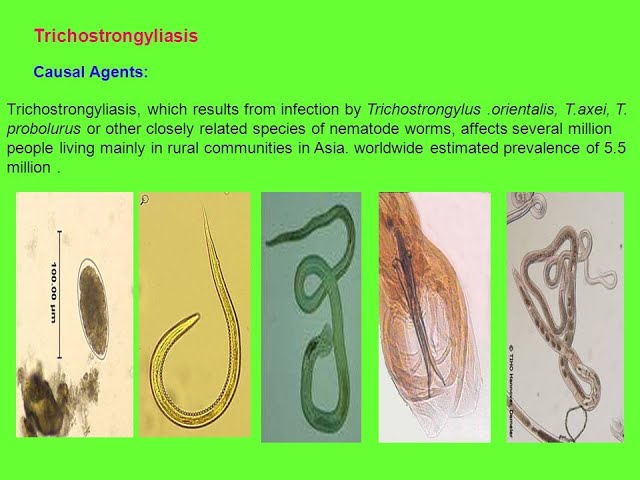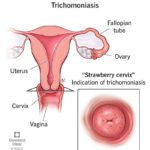Trichostrongyliasis is a zoonotic parasitic infection caused by nematodes of the genus Trichostrongylus, primarily affecting the gastrointestinal tract. This soil-transmitted helminthiasis is prevalent in regions where humans live in close contact with herbivorous animals, resulting in significant public health concern due to its morbidity and diagnostic challenges. A detailed understanding of its epidemiology, clinical manifestations, diagnostic methods, and treatment options is vital for effective management.

Etiology and Life Cycle of Trichostrongyliasis
Trichostrongylus species are nematode parasites predominantly infecting ruminants but occasionally transmitted to humans. The infection occurs through ingestion of infective larvae present in contaminated soil or vegetation.
- Life Cycle: Eggs passed in feces hatch in the environment, developing into infective third-stage larvae (L3) that contaminate plants or soil. Human infection occurs via oral ingestion of these larvae.
- Primary Hosts: Domestic livestock such as cattle, sheep, and goats.
- Human Infection: Accidental and generally occurs in rural, agricultural communities.
Epidemiology and Risk Factors for Trichostrongyliasis
Trichostrongyliasis is most prevalent in tropical and subtropical climates with poor sanitation and close human-animal interaction. Key risk factors include:
- Agricultural activities involving livestock
- Consumption of unwashed or raw vegetables and herbs
- Inadequate sanitation and hygiene practices
- Socioeconomic conditions favoring exposure to contaminated soil
Clinical Manifestations: Recognizing Trichostrongyliasis Symptoms
The clinical presentation varies according to parasite load and host immune response. Symptoms range from mild gastrointestinal disturbances to severe malabsorption syndromes.
- Mild Infection: Often asymptomatic or mild abdominal discomfort.
- Moderate to Severe Infection:
- Diarrhea and abdominal pain
- Nausea and vomiting
- Weight loss and anorexia
- Malabsorption leading to nutritional deficiencies
- Eosinophilia in peripheral blood as a hallmark of parasitic infection
- Chronic Cases: Can lead to growth retardation in children and general debilitation.
Diagnostic Techniques for Trichostrongyliasis
Accurate diagnosis hinges on a combination of clinical suspicion and laboratory findings:
- Stool Microscopy: Detection of characteristic strongylid eggs; however, differentiation from other nematode eggs may be difficult.
- Concentration Techniques: Enhance egg detection sensitivity.
- Serological Tests: Limited availability but useful in chronic or low-intensity infections.
- Molecular Methods: PCR assays offer high specificity but are not widely accessible in endemic regions.
Effective Treatment Strategies for Trichostrongyliasis
Pharmacological intervention focuses on anthelmintic agents with proven efficacy against nematodes:
- First-line Treatment: Albendazole and mebendazole are highly effective, administered orally over 3 days.
- Alternative Options: Ivermectin has shown efficacy in some cases.
- Supportive Care: Nutritional supplementation in cases of malabsorption and chronic infection.
- Follow-up: Repeat stool examinations are necessary to confirm eradication.
Prevention and Control Measures for Trichostrongyliasis
Reducing the burden of trichostrongyliasis requires integrated approaches targeting transmission and exposure:
- Improving sanitation to prevent soil contamination with feces
- Promoting the washing and proper cooking of vegetables and herbs
- Educating communities about zoonotic transmission risks
- Implementing regular deworming programs for livestock
- Encouraging the use of footwear to reduce soil contact
Public Health Impact and Research Directions
Though often overlooked, trichostrongyliasis can significantly impact nutritional status and overall health in endemic populations. Current research is focusing on:
- Developing rapid and cost-effective diagnostic tools
- Investigating drug resistance patterns in parasite populations
- Enhancing community-level education and intervention programs
Comprehensive Management of Trichostrongyliasis
A multifaceted strategy involving accurate diagnosis, effective treatment, and robust prevention is imperative to control trichostrongyliasis. Collaboration between healthcare providers, veterinary services, and public health officials can mitigate transmission, reduce morbidity, and improve quality of life in affected communities.
Frequently Asked Questions:
Q1. How is trichostrongyliasis transmitted to humans?
Through ingestion of infective larvae on contaminated vegetables or soil.
Q2. What are the common symptoms of trichostrongyliasis?
Diarrhea, abdominal pain, weight loss, and eosinophilia.
Q3. Which medications are effective for treating trichostrongyliasis?
Albendazole and mebendazole are first-line treatments.
Q4. Can trichostrongyliasis be prevented?
Yes, through sanitation, proper food hygiene, and livestock management.
Q5. Is trichostrongyliasis common worldwide?
It is mainly prevalent in tropical and subtropical agricultural communities.

